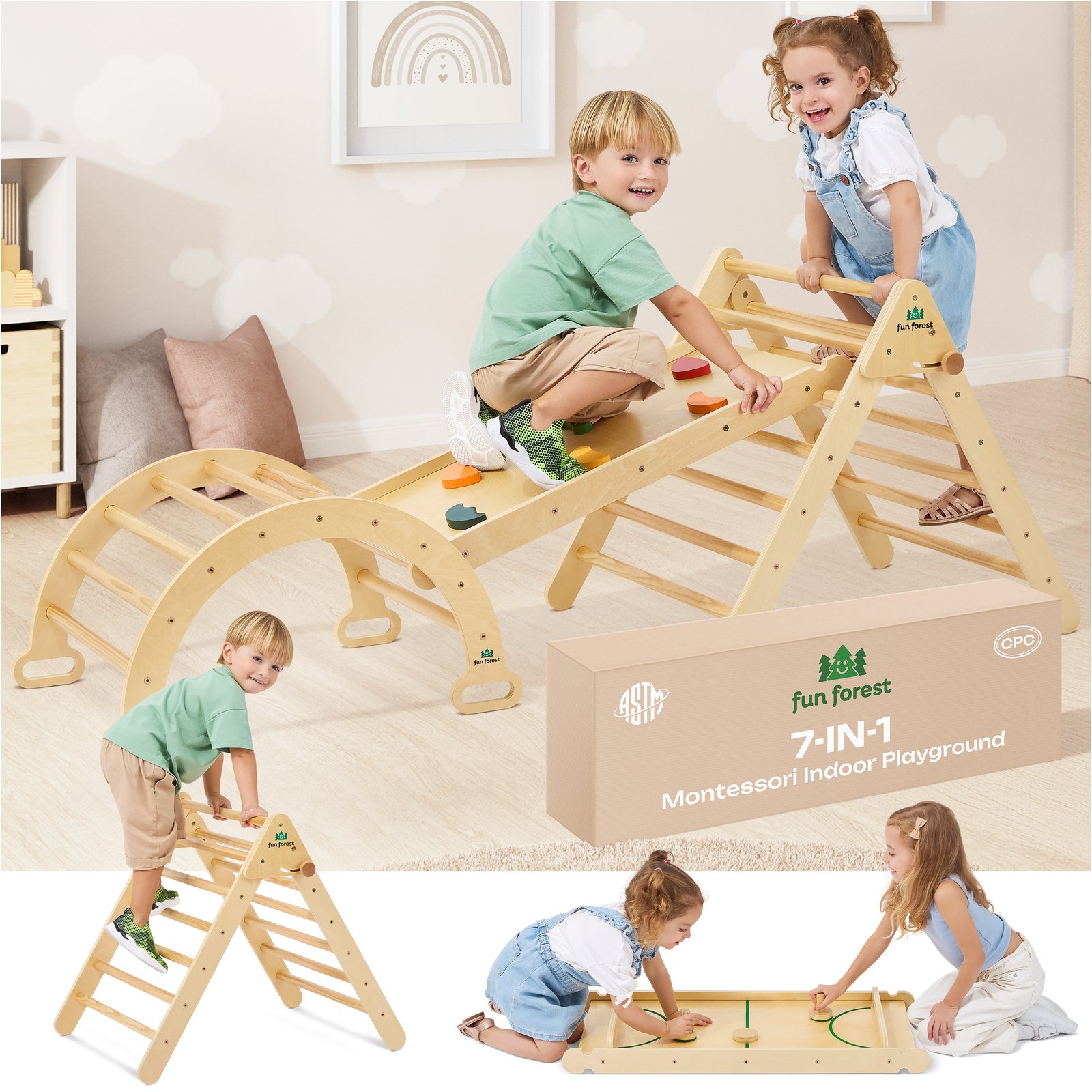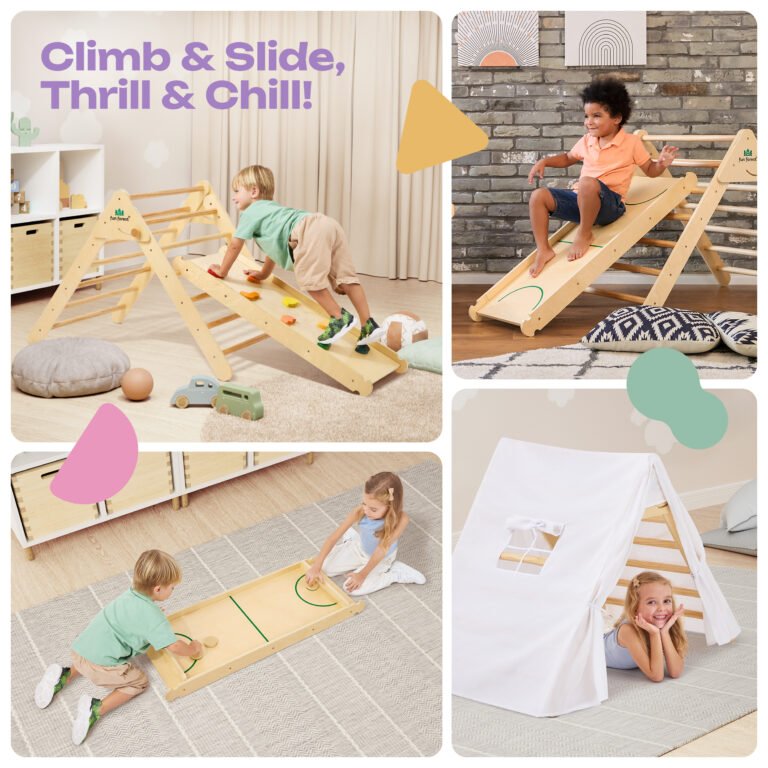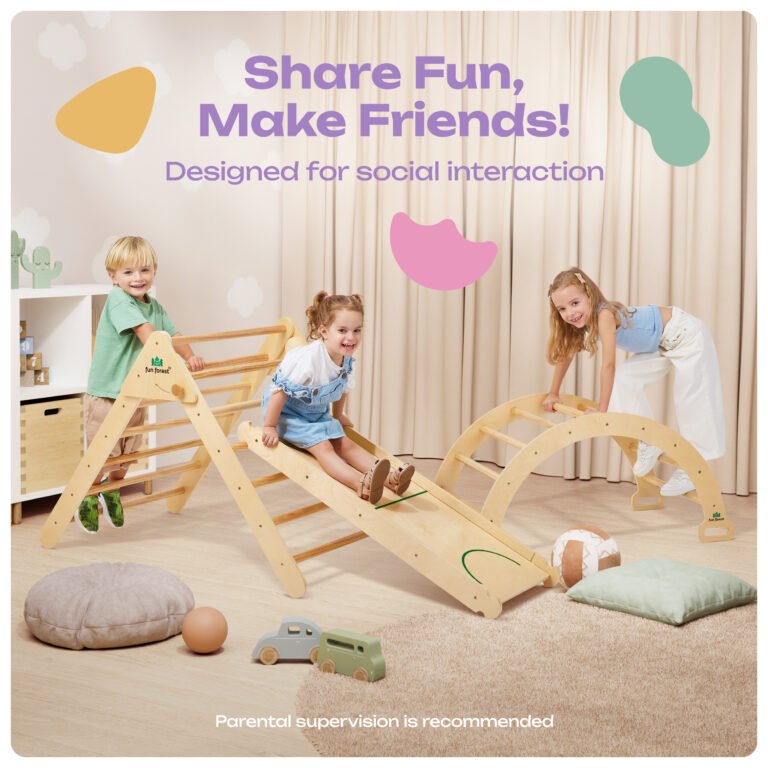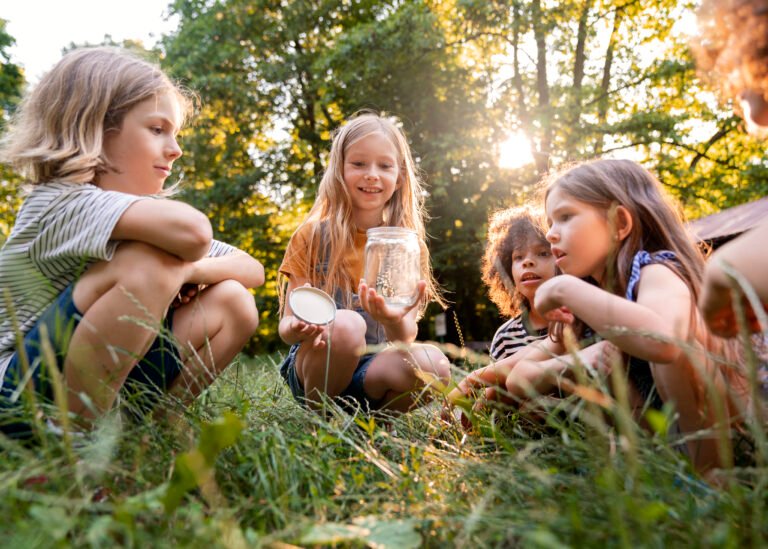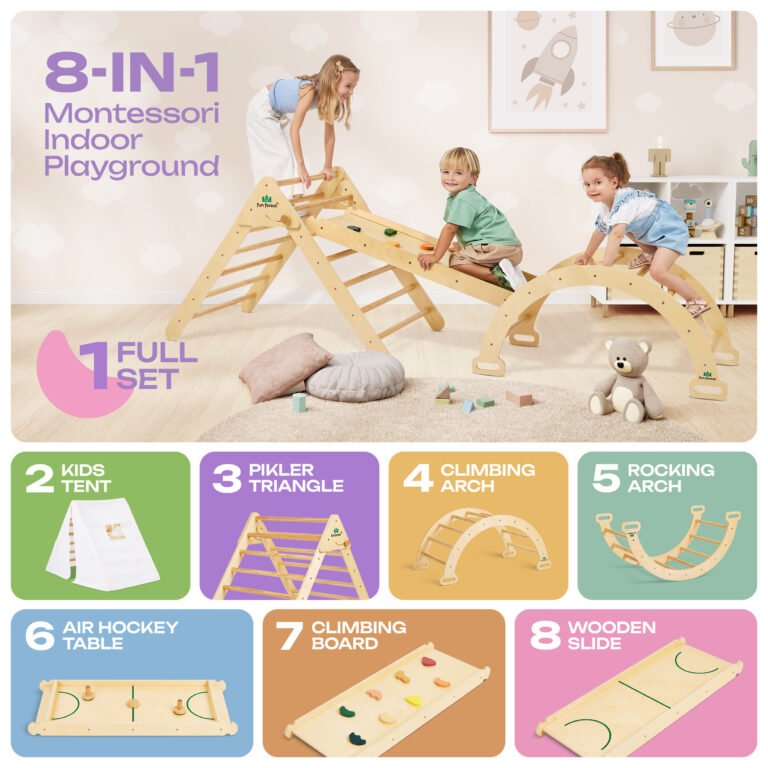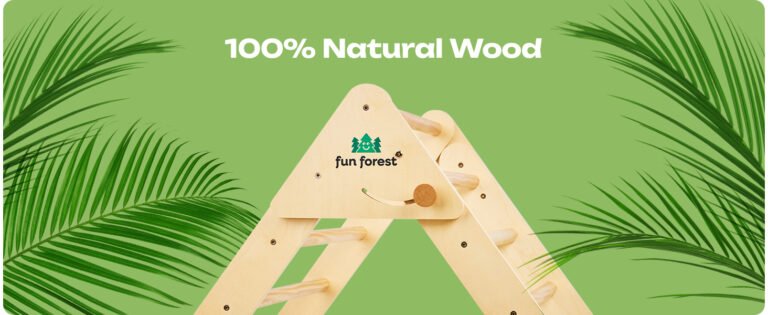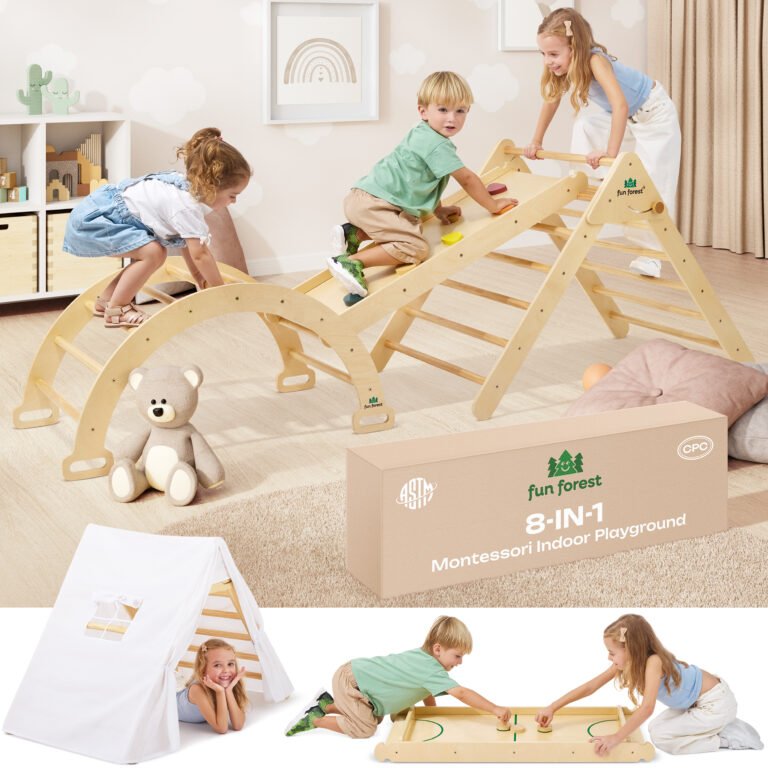How a Pikler Triangle Transforms Your Child’s Development and Motor Skills
Every parent witnesses those magical moments when their child suddenly masters a new skill—taking their first steps, climbing onto the couch, or confidently navigating playground equipment. But what if there was a way to support and accelerate this natural development in the safest, most joyful way possible?
Enter the Pikler triangle: a deceptively simple wooden climbing structure that has been quietly revolutionizing child development for over 75 years. Far from being just another toy, this carefully designed piece of equipment serves as a comprehensive developmental tool that supports your child’s growth across multiple domains—physical, cognitive, emotional, and social.
Let’s explore the remarkable ways a Pikler triangle can transform your child’s development and set the foundation for lifelong physical confidence and competence.
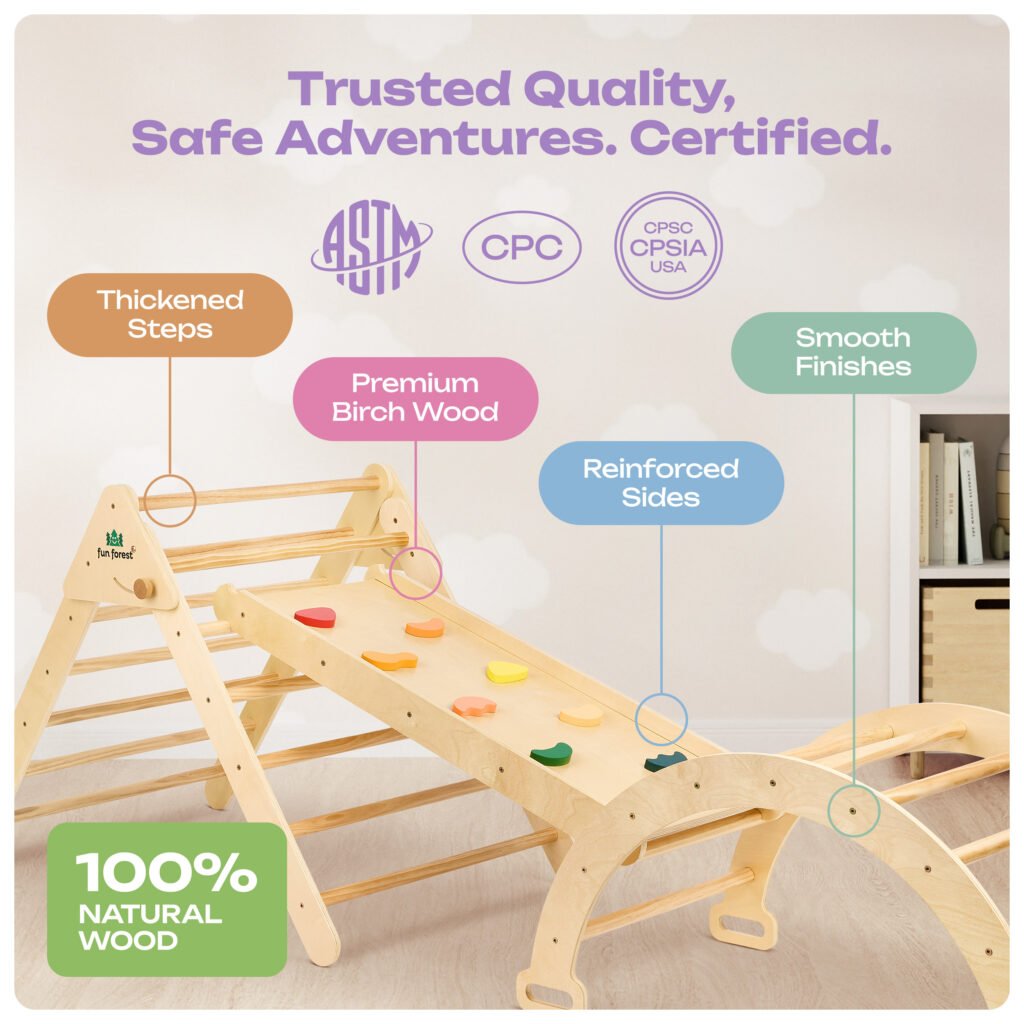
Understanding Child Development Through Movement
The Foundation of All Learning
Modern neuroscience confirms what Dr. Emmi Pikler observed decades ago: movement is the foundation of all learning and development. Every time your child moves, they’re not just building muscle—they’re building brain connections that support:
Cognitive Development:
- Neural pathway formation: Physical movement creates new brain connections
- Spatial reasoning: Understanding how the body moves through space
- Problem-solving skills: Figuring out how to navigate physical challenges
- Executive function: Planning, decision-making, and impulse control
Emotional Development:
- Self-confidence: Success in physical challenges builds overall confidence
- Emotional regulation: Physical activity helps manage emotions and stress
- Resilience: Learning to overcome challenges and try again
- Independence: Developing the confidence to explore and try new things
Social Development:
- Body awareness: Understanding personal space and social boundaries
- Risk assessment: Learning to evaluate situations and make safe choices
- Communication: Expressing needs and coordinating with others
- Cooperation: Working with others in shared physical spaces
The Science Behind Pikler Triangle Development
Gross Motor Skills: The Big Picture
Gross motor skills involve the large muscle groups and whole-body movements that form the foundation for all physical activity:
Core Strength Development:
- Climbing up: Engages abdominal muscles, back, and shoulders
- Maintaining position: Requires constant core stabilization
- Reaching across rungs: Challenges rotational strength and stability
- Controlled descent: Develops eccentric muscle control
Real Impact: Children with strong core muscles show better posture, improved endurance, and reduced injury risk in all physical activities.
Balance and Coordination:
- Static balance: Holding positions while planning next moves
- Dynamic balance: Maintaining stability while moving
- Bilateral coordination: Using both sides of the body together
- Cross-lateral movement: Coordinating opposite arms and legs
Real Impact: Superior balance and coordination translate to better performance in sports, reduced falls, and increased confidence in physical activities.
Strength and Endurance:
- Functional strength: Building muscle power through natural movement
- Grip strength: Developing hand and forearm muscles
- Leg power: Strengthening through pushing and pulling movements
- Cardiovascular fitness: Heart and lung development through active play
Real Impact: Children develop the strength and endurance needed for playground activities, sports participation, and daily physical tasks.
Fine Motor Skills: The Precision Connection
While Pikler triangles primarily target gross motor development, they also significantly impact fine motor skills:
Hand and Finger Strength:
- Grip development: Holding rungs builds hand strength
- Finger dexterity: Precise placement and adjustment of hand position
- Bilateral hand use: Coordinating both hands for different functions
- Pressure regulation: Learning appropriate grip strength
Real Impact: Strong hands and fingers are essential for writing, drawing, cutting with scissors, and using tools effectively.
Hand-Eye Coordination:
- Visual guidance: Using eyes to guide hand placement
- Depth perception: Judging distances for accurate reaching
- Timing coordination: Synchronizing visual input with hand movement
- Precision placement: Accurate positioning of hands and feet
Real Impact: Hand-eye coordination is crucial for academic tasks like writing, sports performance, and everyday activities.
Age-Specific Developmental Benefits
Infants (6-12 months): Foundation Building
Motor Skill Development:
- Pulling to stand: Using triangle rungs to practice standing
- Weight bearing: Strengthening legs for future walking
- Grip strength: Developing hand muscles through grasping
- Balance reactions: Learning to maintain upright position
Cognitive Benefits:
- Cause and effect: Understanding how actions create results
- Spatial awareness: Beginning to understand height and distance
- Problem-solving: Figuring out how to reach desired positions
- Memory formation: Remembering successful movement patterns
Emotional Development:
- Confidence building: Success in physical challenges builds self-esteem
- Independence: Learning to move without constant adult assistance
- Frustration tolerance: Working through physical challenges
- Joy in movement: Developing positive associations with physical activity
Toddlers (12-36 months): Skill Expansion
Advanced Motor Skills:
- Confident climbing: Reaching higher rungs with coordination
- Descent skills: Learning to come down safely and efficiently
- Movement planning: Thinking ahead about climbing routes
- Risk assessment: Beginning to evaluate challenges appropriately
Cognitive Advancement:
- Sequential thinking: Planning multi-step climbing sequences
- Spatial reasoning: Understanding three-dimensional navigation
- Memory integration: Applying learned techniques to new situations
- Attention development: Sustained focus on physical challenges
Social-Emotional Growth:
- Self-regulation: Managing emotions during challenging activities
- Persistence: Continuing to try despite initial failures
- Pride in achievement: Celebrating personal accomplishments
- Help-seeking: Learning when to ask for assistance
Preschoolers (3-5 years): Mastery and Creativity
Complex Motor Patterns:
- Advanced coordination: Smooth, efficient movement sequences
- Creative movement: Inventing new ways to use the structure
- Speed control: Moving quickly while maintaining safety
- Teaching others: Demonstrating techniques to younger children
Sophisticated Cognitive Skills:
- Abstract thinking: Using triangle in imaginative play scenarios
- Rule understanding: Creating and following climbing games
- Strategy development: Planning complex climbing challenges
- Teaching ability: Explaining techniques to others
Leadership Development:
- Mentorship: Helping younger children learn climbing skills
- Safety awareness: Protecting others while playing
- Communication: Expressing ideas and coordinating group activities
- Responsibility: Taking care of equipment and others’ well-being
The Neurological Impact of Climbing
Brain Development Through Movement
Vestibular System Activation:
- Balance processing: Inner ear sensors activated by position changes
- Spatial orientation: Understanding body position relative to gravity
- Movement integration: Coordinating balance with visual and proprioceptive input
- Attention regulation: Vestibular input supports focus and calm
Research Finding: Children with well-developed vestibular systems show better attention, reading skills, and emotional regulation.
Proprioceptive Development:
- Body awareness: Understanding where body parts are in space
- Force regulation: Learning how much pressure to apply
- Movement precision: Fine-tuning motor control through feedback
- Safety sensing: Internal awareness that prevents injury
Research Finding: Strong proprioceptive systems correlate with better academic performance and social skills.
Cross-Lateral Brain Integration:
- Hemisphere communication: Both sides of brain working together
- Reading readiness: Neural patterns needed for academic success
- Coordination improvement: Better integration of complex movements
- Cognitive flexibility: Enhanced problem-solving abilities
Research Finding: Cross-lateral movement activities significantly improve academic performance and learning ability.
Physical Development Milestones
Strength Building Through Natural Movement
Progressive Strength Development:
Unlike artificial exercise programs, Pikler triangle climbing builds functional strength through natural, joyful movement:
Month 1-3: Basic grip strength and pulling motions Month 3-6: Core engagement and leg strengthening Month 6-12: Complex movement patterns and endurance Year 2+: Advanced coordination and creative movement
Postural Development:
- Core stability: Strong abdominal and back muscles
- Shoulder girdle strength: Upper body support for future activities
- Hip stability: Foundation for walking, running, and jumping
- Spinal alignment: Proper posture development
Long-term Impact: Children develop the postural strength needed for classroom sitting, sports participation, and lifelong physical health.
Coordination and Balance Mastery
Balance System Integration:
- Visual balance: Using eyes to maintain stability
- Vestibular balance: Inner ear contribution to stability
- Proprioceptive balance: Body awareness contribution
- Motor balance: Muscle response integration
Coordination Pattern Development:
- Unilateral patterns: One side of body working independently
- Bilateral patterns: Both sides working together
- Cross-lateral patterns: Opposite sides coordinating
- Rotational patterns: Twisting and turning movements
Academic Connection: These movement patterns are essential for reading, writing, and mathematical thinking.
Cognitive Development Through Physical Challenge
Executive Function Building
Planning and Problem-Solving:
- Route planning: Thinking ahead about climbing strategies
- Obstacle navigation: Figuring out how to overcome challenges
- Risk assessment: Evaluating safety and difficulty
- Decision making: Choosing appropriate challenges
Working Memory Development:
- Sequence retention: Remembering multi-step climbing patterns
- Technique storage: Maintaining successful movement strategies
- Pattern recognition: Identifying familiar climbing challenges
- Transfer skills: Applying learned techniques to new situations
Attention and Focus:
- Sustained attention: Maintaining focus during climbing sequences
- Selective attention: Focusing on relevant climbing cues
- Divided attention: Monitoring multiple aspects simultaneously
- Attention flexibility: Shifting focus as situations change
Academic Impact: These executive function skills directly support classroom learning, homework completion, and academic success.
Spatial and Mathematical Thinking
Spatial Reasoning Development:
- Three-dimensional thinking: Understanding how objects relate in space
- Distance estimation: Judging reach and gap distances
- Angle comprehension: Understanding slopes and positions
- Perspective taking: Seeing situations from different viewpoints
Mathematical Concept Foundation:
- Measurement understanding: Concepts of height, distance, and size
- Geometric thinking: Triangles, angles, and spatial relationships
- Pattern recognition: Identifying sequences and repetitions
- Counting and sequencing: Numerical concepts through movement
STEM Connection: Physical spatial experiences provide the foundation for advanced mathematical and scientific thinking.
Emotional and Social Development Benefits
Self-Confidence and Independence
Genuine Achievement:
- Internal motivation: Success driven by personal challenge, not external rewards
- Skill mastery: Real competence building through practice and persistence
- Risk management: Learning to assess and take appropriate risks
- Independence: Ability to engage in self-directed physical activity
Resilience Building:
- Failure tolerance: Learning that setbacks are part of learning
- Persistence: Continuing efforts despite initial difficulties
- Problem-solving confidence: Belief in ability to overcome challenges
- Emotional regulation: Managing frustration and excitement
Life Impact: These emotional skills support success in school, relationships, and future challenges.
Social Skills Through Physical Play
Cooperation and Communication:
- Turn-taking: Sharing climbing space respectfully
- Safety communication: Warning others of potential hazards
- Encouragement: Supporting others’ efforts and celebrating success
- Conflict resolution: Working through disagreements about space and rules
Leadership and Following:
- Teaching skills: Helping others learn climbing techniques
- Modeling behavior: Demonstrating safe and appropriate climbing
- Following instructions: Learning from more experienced climbers
- Team coordination: Working together on complex climbing challenges
Social Impact: These interpersonal skills support friendship formation, classroom cooperation, and future leadership opportunities.
Supporting Your Child’s Development Journey
Creating the Optimal Environment
Physical Setup:
- Safe landing surfaces: Appropriate padding for falls and jumps
- Adequate space: Room for full range of movement around triangle
- Good lighting: Clear visibility for safe climbing
- Hazard-free zone: Removing sharp edges and hard objects
Emotional Environment:
- Encouragement without pressure: Supporting attempts without forcing advancement
- Celebration of effort: Recognizing trying as much as achieving
- Safety first: Clear boundaries that protect while allowing exploration
- Patience with development: Understanding that skills develop at individual paces
Maximizing Developmental Benefits
Daily Integration:
- Regular access: Making climbing available as part of daily routine
- Varied use: Different times of day for different energy levels
- Seasonal adaptation: Indoor and outdoor use as appropriate
- Growth accommodation: Adjusting challenges as skills develop
Family Involvement:
- Shared enjoyment: Parents participating appropriately in climbing activities
- Sibling interaction: Encouraging cooperative climbing and teaching
- Documentation: Celebrating progress through photos and observations
- Professional support: Consulting with occupational therapists if needed
The Fun Forest Developmental Advantage
When choosing a Pikler triangle to support your child’s development, quality and design matter significantly:
🌲 Fun Forest Pikler Triangle
Optimized for Complete Development:
🧠 Cognitive Enhancement: Perfect proportions stimulate spatial reasoning and problem-solving
💪 Motor Skill Mastery: Graduated challenges build strength, coordination, and balance systematically
❤️ Emotional Growth: Safe challenges build genuine confidence and resilience
👫 Social Development: Design encourages cooperation and communication
🏆 Quality Construction: Durable materials support years of developmental use
🛡️ Safety First: All features designed to support development while maintaining safety
Developmental Features:
- Age-appropriate progression: Natural advancement from basic to complex skills
- Multi-domain support: Benefits physical, cognitive, emotional, and social development
- Long-term engagement: Continues to challenge children through multiple developmental stages
- Evidence-based design: Based on decades of child development research
🎯 Complete Fun Forest Pikler Set
Maximum Developmental Impact:
🎪 Comprehensive Challenge: Multiple configurations support all areas of development
📈 Progressive Difficulty: Natural advancement system grows with your child
🤝 Enhanced Social Play: Multiple components encourage cooperation and communication
🧩 Cognitive Complexity: Varied configurations stimulate advanced problem-solving
🏃 Physical Diversity: Multiple movement patterns support complete motor development
🌟 Family Integration: Components work for multiple children and various developmental stages
Complete Set Developmental Advantages:
- Sustained engagement: Variety prevents developmental plateaus
- Complex skill building: Advanced configurations support sophisticated motor patterns
- Enhanced creativity: Multiple components inspire imaginative play and problem-solving
- Family development: Supports entire family’s physical activity and cooperation
The Long-Term Impact of Early Movement
Foundation for Lifelong Health
Children who experience rich movement opportunities early in life show:
Physical Benefits:
- Improved fitness: Higher activity levels throughout childhood and beyond
- Better coordination: Enhanced performance in sports and physical activities
- Injury prevention: Better body awareness and movement control
- Lifelong activity: Positive associations with physical movement
Academic Benefits:
- Enhanced learning: Better attention, memory, and processing speed
- Improved reading: Stronger visual tracking and processing skills
- Mathematical thinking: Spatial reasoning supports STEM learning
- Executive function: Better planning, organization, and self-control
Social-Emotional Benefits:
- Increased confidence: Physical competence supports overall self-esteem
- Better relationships: Cooperation and communication skills transfer to all relationships
- Resilience: Problem-solving confidence supports handling life challenges
- Leadership: Physical confidence often translates to social leadership
Your Child’s Developmental Journey Starts Here
Every climb, every careful step, every successful navigation to the top builds more than just physical strength—it builds the foundation for your child’s success in all areas of life. The neural pathways formed during early movement experiences shape learning, relationships, and confidence for years to come.
A Pikler triangle isn’t just play equipment—it’s a comprehensive developmental tool that honors your child’s natural drive to move while providing the structured support they need to build genuine competence and confidence.
Ready to give your child the developmental foundation they deserve?
🌟 Start your child’s developmental journey with the Fun Forest Pikler Triangle – Perfect for supporting complete child development through joyful movement
🎯 Maximize developmental impact with the Complete Fun Forest Set – Comprehensive support for all areas of child development
Your child’s development happens every day, with every movement, with every challenge they overcome. Give them the tools to build strength, confidence, and competence that will serve them throughout their lives.
Because the best development happens when children can move, explore, challenge themselves, and discover what their amazing bodies and minds can accomplish together.
Learn more in our complete Pikler Triangle guide

